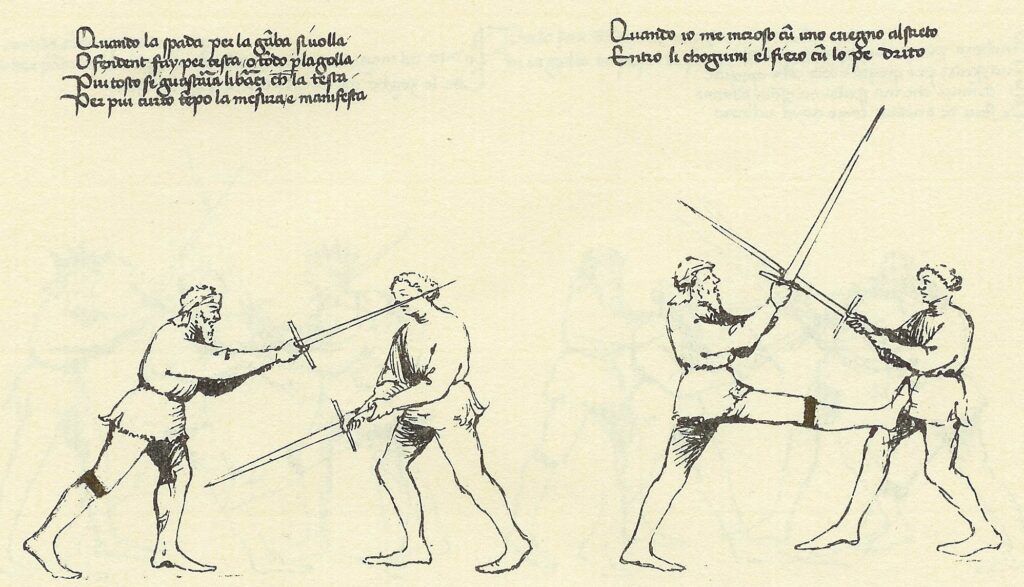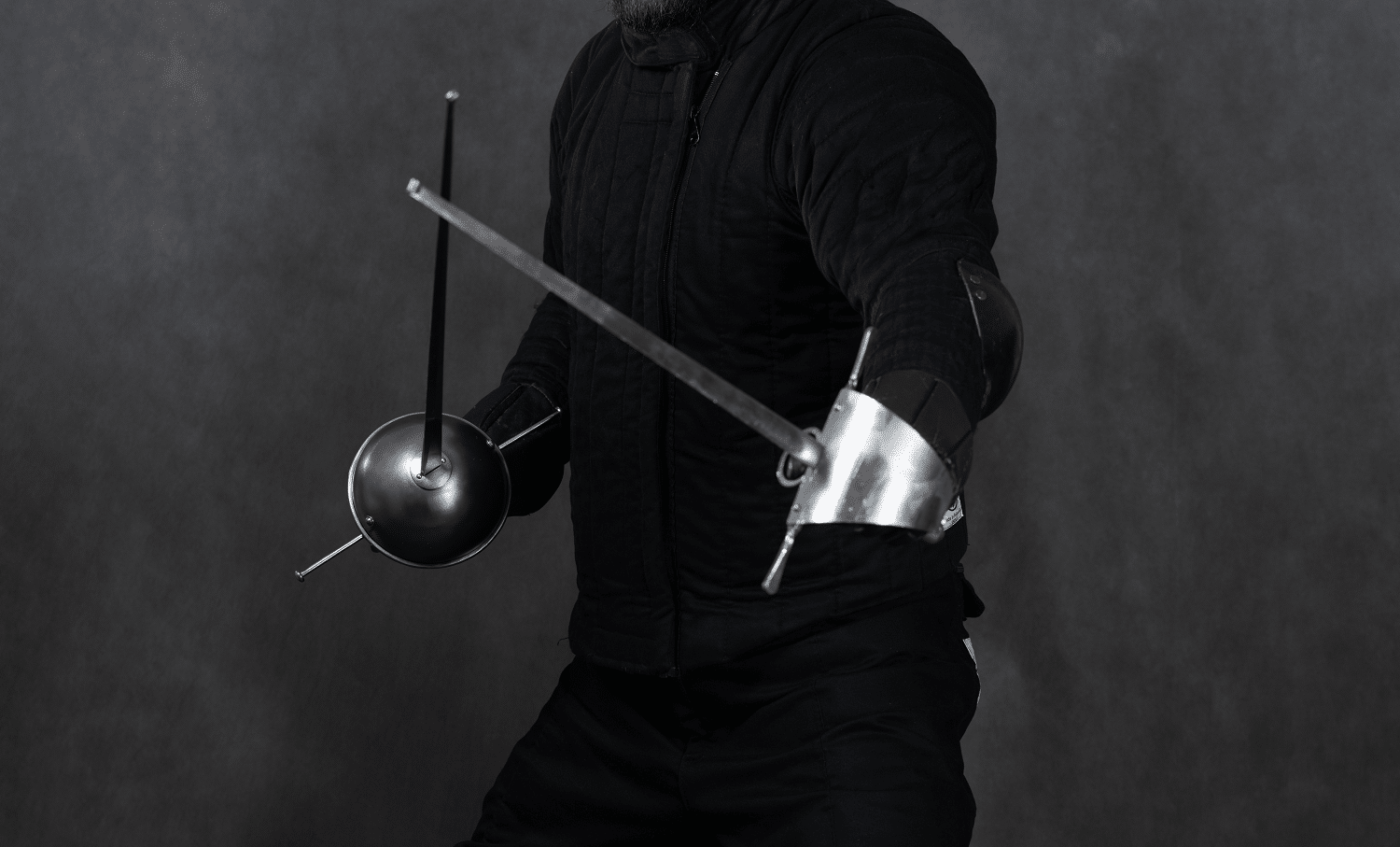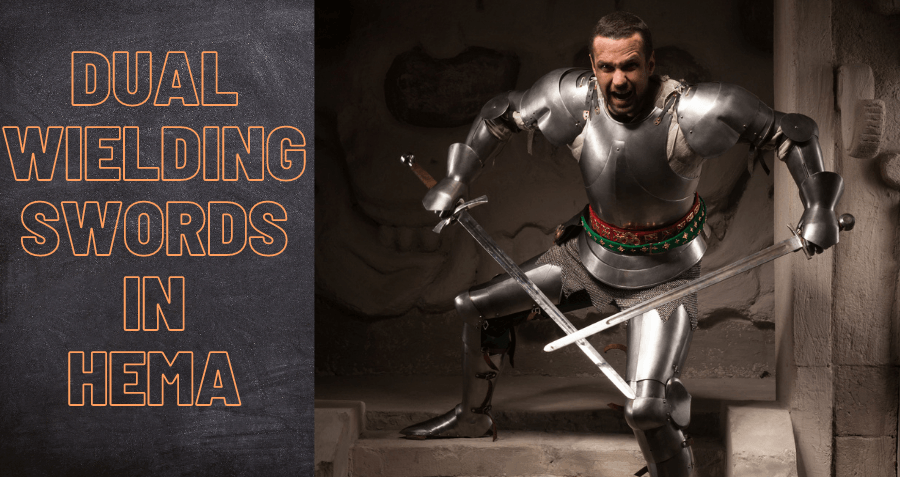Kicking is often considered by the general public to not be a major part of Historical European sword fighting or martial arts in general. Many martial artists today even think that kicking is something invented by Asian martial artists, as there are several martial arts from that region that have emphasis on kicking techniques. Yet kicking was not exclusive to only the Asian martial artists; European martial artists also practiced the kick.
Were Kicks Used in Historical European Martial Arts?
Yes. There is evidence for combat techniques that involved kicking in European martial arts dating back to at least the medieval period. An excellent example is from one of the oldest surviving martial arts treatises, The Flower of Battle (Fior di Battaglia, Flos Duellatorum) written by a 14th century Imperial Free Knight of the Holy Roman Empire, Fiore dei Liberi.
In the work of Fiore we see creative use of the feet. His fencing style is brutally practical and certainly doesn’t assume any rules will be followed in a fight. The written records of his style studied by HEMA athletes cover a handful of different weapons and situations; Fiore shows plays that involve holds, grapples and other ways of gaining an advantage. Some of these holds use the legs to prevent the opponent from moving in a certain way.
Fiore has several plays that incorporate kicks to the groin and knees of the opponent, even while sword fighting. These kicks are often delivered from a position called the bind in sword fighting vernacular, a position where blades are locked in combat briefly as each fighter tries to gain leverage and advantage over the other. Here is an illustration from the Pisani Dossi version of The Flower of Battle depicting some kicks used during long sword combat plays.


One kick demonstrated in one of Fiore’s plays is used as a way to break out of a bind, while the other is aimed at the groin of the opponent. Both of these kicks would seriously injure the opponent and reduce their movement, although the groin kick is probably the most damaging between the two.
We talk more about Fiore dei Liberi in our article, “Who was Fiore dei Liberi? What is Armizare?” for those interested in learning more about Italian medieval swordfighting.
As another example, from the German swordfighting Liechtenauer tradition (also known as Kunst des Fechtens) we have these illustration from a manuscript attributed to Hans Talhoffer in the 15th century, which also depict the usage of kicks in long sword combat.


You can learn more about Kunst des Fechtens in our article, “The Johannes Liechtenauer Tradition and the German School of Fencing“.
As yet another example, in Klare Onderrichtinge der Voortreffelijke Worstel-Konst (“Clear Education in the Magnificent Art of Wrestling”), a martial arts manual written by 17th century Nicolaes Petter there is an illustration accompanying the usage of kick to defend against a knife attack,

So although these treatises and the martial arts they describe are not as widely known among the general public today, the evidence is clear: European people have been practicing the usage of kicks in martial arts for many centuries and it was not introduced to Western countries by Asian martial artists, as is often mistakenly believed by many people today.
Using Kicks in HEMA Tournaments?
Luckily for the participants in modern HEMA tournaments, rules for event matches are not necessarily accurate recreations of real combat. Though the goal of HEMA tournaments is often to test interpretations, there are limits. Therefore most kicking done in HEMA isn’t so much done at tournaments but in the club hall.
Seeing as there aren’t a lot of real sword fights going on today that we can learn from, the techniques used in modern sword sports can give us the most concrete information on the usefulness of kicking in swordplay that we’ll be able to find today. Yet few sword martial arts tournaments will engage in kicking.
Modern Olympic Fencing is probably the best known sword sport, and anyone who has ever watched a match would find it hard to imagine anyone being kicked. In the USA rules of fencing any action deemed “irregular” is strictly forbidden. A kick of any sort would likely fall under that umbrella.
Kendo allows marginally more in the way of foot based combat, with a leg sweep being used in more traditional Kendo (which has had a recent resurgence) but not in the more common mainstream versions of Kendo. The most kick-tolerant sword sport is a more recent HEMA, or historical European martial arts movement.
By contrast in HEMA some tournaments may allow plays that utilize kicks,. Although this is not common it is more than you would see in Olympic style fencing or Kendo today. Because the protective gear worn by HEMA competitors isn’t suited to defend against foot strikes, performing a kick at full force as the plays intend them could seriously hurt an opponent. On the other hand tournaments usually award points only when a blade makes contact, so using a kick without giving it enough force to open your opponent up for a sword strike usually won’t be beneficial anyway.
Because of these limitations participants are usually only allowed to kick in longsword matches if at all, where a straight kick can be used when the fighters are in the bind in order to create distance and leave a foe off-balanced. The kick must make contact with the torso and a sidekick will generally not be permitted.
In high level longsword matches both participants are likely to be skilled enough that a bind will never last long enough to allow for one of them to swing their leg up for a kick. Fortunately for the kick enthusiasts among us, many schools do study the older sources on historical European martial arts and practice plays that incorporate kicks.
What About Kicking in Rapier Fencing?
The idea of the rapier as an elegant weapon to be used in gentlemanly duels has endured in popular media such as movies, with many films such as The Three Musketeers and The Princess Bride showing a lot of fancy rapier swinging and even some kicking techniques during all of the swashbuckling action. And it is true that in the Renaissance era when rapier swords were most popular that they were carried for self-defense, being relatively light and easy to maneuver compared to a larger blade, and much more reliable than the firearms of the day. Yet actual historically accurate rapier combat is not what we see in these films.
Through examination of surviving documentation on Renaissance era rapier sword fighting it is safe to assume that kicks within rapier dueling was not very common. Given the length of the blade in question and the way that stances are focused around the usage of the lunge, the fighters just are not well positioned for kicking.
With all the information we’ve discussed so far we can start to figure out what kind of sword-fighting situations would warrant a kick. It depends on the weapon, your range from the opponent, your skill level and even the social context of the fight. While there are definitely many examples we can see in these records, it is clear kicks were something primarily used as a tactic to help open an opponent up so they are easier to stab with a weapon.
Closing Thoughts
It’s been a long time since real sword fights were a regular occurrence and that results in the gradual loss of understanding concerning how a real fight might play out. Without getting into a handful of real bouts and putting ourselves in real danger there’s no way to be sure on precisely just how these sword fights would go down, but it’s important nonetheless to think critically about these things. Although we no longer have reasons to carry swords for self defense nor need to learn how to fight to kill with a blade, for purposes of reconstructing these lost techniques for modern day sword sports, and new ways to develop stage choreographed sword fights for movies, it’s good to research this topic further. The more deeply we think about the roots of swordplay and techniques used during a sword fight, the more interesting and realistic our reconstructed versions will be.
Partial Bibliography
Tausk, Gene P. “The Use of Kicks in Swordfighting: A Brief Exploration” The Association for Renaissance Martial Arts, ARMA Online [Online] Available at: http://www.thearma.org/essays/kicks.htm#.Xuv-x0VKhPY [Accessed 13 September 2020]
“Nicolaes Petter” Wiktenauer [Online] Available at: https://www.wiktenauer.com/wiki/Nicolaes_Petter [Accessed 10 September 2020]
*****
We hope this guide helps you start your journey into learning historical sword fighting.
If you’d like to learn more information about historical fencing practices please check out our Learn HEMA page for a guide to learning about the historical weapon that interests you. You can also find more guides we’ve written about other topics at our Helpful Guides page. You can also join the conversation at our forums or our Facebook Group community.
















